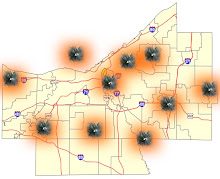In the past week, the Beck Center for the Arts in Lakewood, an inner-ring Cleveland suburb, announced it was studying a possible move to a booming and bustling "neighborhood", a lifestyle center in outer-ring Westlake, called Crocker Park.
Much consternation erupted from sectors of the Cleveland blogosphere. How could such a venerable institution leave Lakewood? How could an arts organization sell out to the evil developer? Fake urbanism is wrong and despicable! It is not a real city! And on and on.
Let's face it. American urbanism and/or suburbanism of our emerging century will not mirror the urbanism of the last century. These pockets of New Urbanist mixed use should not necessarily be viewed as something aberrational--these conurbations are the harbingers of future "urban" development and must be seriously considered. As populations become ever more mobile and less tethered to certain geographies, routines, and schedules, the normative understandings of "city" and "urbanism" become incrementally obsolete.
So why would not such an organization as the Beck Center want to be involved and ingratiated within the fabric of a potential urban core? The move of the Arts to the booming suburbs is not a phenomena occurring only in Northeast Ohio. This is a trend that Joel Kotkin has been writing about for many years now.
Subscribe to:
Post Comments (Atom)





1 comment:
While I don't doubt that the arts can exist in any number of suburbs, I think that shopping an arts center between adjacent westside communities is hampering growth and availability of cultural amenities to all residents. I don't see why a new performing arts center or ampitheatre can't exist in Westlake and share the westside arts spotlight with the Lakewood Beck Center. In this case, Lakewood continues to be a dense community seeing growth and investment with a strong commitment to the arts (check out the annual Lakewood Arts Festival for a taste) - and not a rapidly declining urban center.
In fact, maybe another arts center on that side of town would convince eastsiders that the westside of the Cuyahoga isn't a cultural wasteland.
Post a Comment